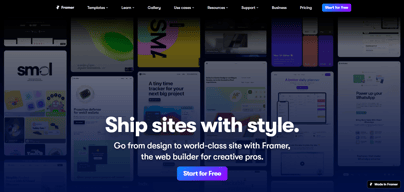

Unclaimed: Are are working at Framer ?
Framer Reviews & Product Details
Framer is a design tool for web designers and developers that lets users create production-ready code. Armed with basic coding knowledge, Framers has tools that can create animated effects, build UI components and tap into code libraries, UI kits, or packages. Framers also support typescripts. With Framer, you get a lot of creative freedom, features a cursor chat, a rapid code editor, Spotify integration, as well as Sketch, Figma, iOS, Photoshop, and more.


| Segment |
|
|---|---|
| Deployment | Cloud / SaaS / Web-Based, Desktop Mac |
| Support | 24/7 (Live rep), Chat, Email/Help Desk, FAQs/Forum, Knowledge Base, Phone Support |
| Training | Documentation |
| Languages | English |
Framer Pros and Cons
- You get a lot of creative freedom
- Framer is available on multiple platforms, and any device running a web browser
- There are a range of different integrations available, including Sketch, Figma, iOS, macOS, Photoshop, and more
- It’s great for prototyping
- Some users have complained about buggy updates
- To take full advantage of Framer, you’ll need some coding know-how
- It lacks some sought after features like text style, which comes with competitors like Sketch





Compare Framer with other popular tools in the same category.

Framer offers an unparalleled design experience with its seamless integration of design and development. It's user-friendly, efficient, and promotes creativity, making it an essential tool for anyone looking to quickly bring their ideas to life.
I don't have any particular dislikes about Framer. However, it could further enhance its capabilities by improving the data handling for exporting and importing data within the CMS. This would streamline the process and make the tool even more powerful.
Framer bridges the gap between design and development, providing a one-stop solution for creating beautiful websites without the need for coding expertise. It has empowered me to realize my designs faster and with more control, significantly reducing development time and effort.
As a seasoned designer always on the lookout for innovative tools, Framer.com instantly grabbed my attention. This powerful web design platform is more than just a design tool - it's a complete ecosystem that revolutionizes the way websites are created and published.
Right now I think what I dislike most is the cost. The pricing plan are quite expensive especially for someone like in that lives in Nigeria
What truly sets Framer.com apart is its unique ability to publish websites directly from the platform. This seamless transition from design to live website eliminates the need to switch between different tools, streamlining the entire web design process. This feature has transformed my workflow, saving time and effort while maintaining design integrity. Collaboration is also a strong suit of Framer.com. The platform facilitates real-time collaboration, allowing team members to contribute irrespective of their physical location. Feedback can be shared effortlessly, promoting a cohesive and efficient design iteration process. This collaborative approach not only enhances teamwork but also bridges the gap between designers and developers.
The ease of desining in figma and publishing in Framer is what keeps me a loyal customer and affiliate of Framer.
Animations and app features such as found in bubble, if they had this, framer would be the designers mecca!
Timing to market. Simple MVP websites.
The ability to quickly create custom components for unique experiences. Out of the box speed and optimisation that framer does on the background. And ability or import designs from Figma.
Their CMS tool is great but is lacking. Also roles and permissions need to be updated I want to invite guests to only edit CMS nf that would mean paying for an entire editor.
Creating beautiful functional websites that are fast and easy to publish. Ability to finish sites faster than with other tools once you get the hang of it.
Framer is one of the most easy to use systems for making websites. It has a clean UI, loads of tutorials, a fantastic team, and a big community behind it to make it all happen. We use it on a daily basis and can't think of a world without it.
There are still some features that Framer is lacking. There are some CMS limitations, we'd like to have a better editor for our clients, and the handover process to a client could be improved.
Framer ensures that you can quickly turn your web design into an actual working website. It's the Figma of web design in my opinion. It has ensured that we can create websites in a faster rate.
Framer is praised for its capabilities in creating interactive prototypes and animations. While it may have a learning curve, there is a supportive community available to provide assistance.
Compared to other website builders like Webflow and Bubble, Framer lacks a robust video documentation library.
For me the uses code as an escape hatch to extend capabilities to, for example, add small dynamic parts to a site
It's crazy how easy you can make a amazing website. I've been using framer for about 5 to 6 months and I'm completely in love with it
For me it's missing a ecommerce integration but the community is working on it
No coding is just simple and straight forward and I think that framer makes it even easier.
How so unlike Wordpress it is. It actually intuitively makes sense
Some of the strangeness when it is obvious someone ported it over from Figma. It feels like the icons off to the side etc could be organized in a better manner
Framer gives me full purpose websites that are modern (react) based and look it. I swore I wouldn't put another client on a wordpress site and I'm sticking to it!
Framer has been the most interesting software program i've used in a very long time. As a SaaS founder I know how important it is to move quickly and ship stuff, and that's exactly what Framer enables you to do. It makes developing your website so easy that it's not uncommon to go from idea > publish to production in just a few hours. Besides that it just gives you so much power that you don't even need to be able to write code or understand how the code structure of a website works. You just need to design and ship it :) Furthermore the community and company is one of the most helpfull environments to be a part of.
I really couldn't tell anything bad about it. They might be young, but have a very sophisticated product allready and at the speed with which they develop this will only get better.
Development time is very expensive and will involve working together with multiple people. With Framer I can design and ship everything myself without the need to add developer time.
Framer is extremely intuitive if you're already familiar with Figma. The community and support is exceptional. The team ships fast.
There are occasional bugs and issues, but it's very easy to get guidance through the community channel.
Framer is the go-to website builder for all products from our venture studio, as well as our own marketing websites.





